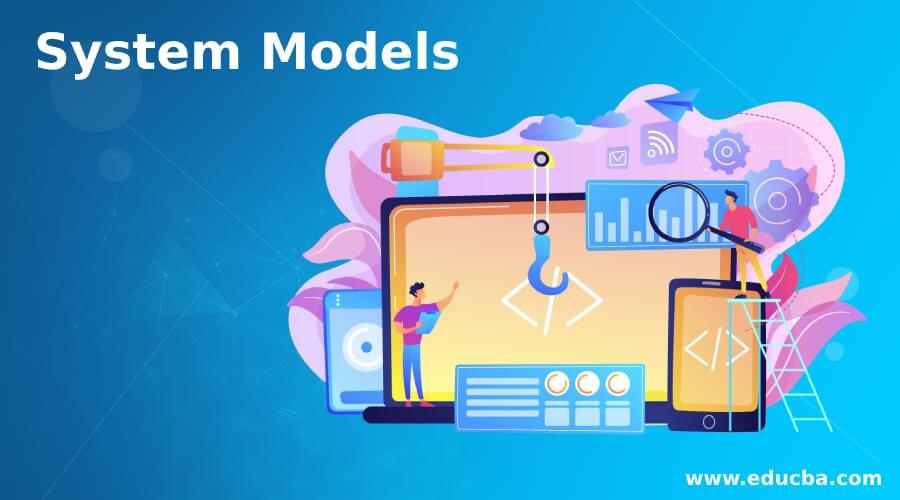Updated July 5, 2023
Introduction to System Models
Models are necessary to understand the project better. They represent the information that software transforms, the functions that enable this transformation, the features that users desire, and the system’s behavior as the transformation occurs. There are various system models like the analysis, system, context, behavioral, data, and object models.
Various System Models
Given below are the various system models:
1. Analysis Model
The analysis model represents the user requirements by depicting the software in three domains: information, functional, and behavioral. This model is multidimensional. If any deficiency remains in the analysis model, then the errors will be found in the ultimate product to be built. The design modeling phase depends on the analysis model. The analysis model depicts the software’s data requirements, functions, and behavior to be built using diagrammatic form and text.
It is mainly designed by a software engineer, system analyst, modeler, or project manager. This model describes the problem from the user’s end. The essence of the problem is described without considering how a solution will be implemented, and implementation details indicate how the essence will be implemented.
2. Design Model
The design Model provides various views of the system, just like the architectural plan for House. The construction of the design model utilizes different methods, such as data-driven, pattern-driven, or object-oriented methods. And all these methods use design principles for designing a model. The design must be traceable to the analysis model. User interfaces should consider the user first. Always consider the architecture of the system to be built. Focus on the design of data. Component-level design should exhibit functional independence. Both user and internal must be designed. Components should be loosely coupled.
3. Context Model
The boundaries of a system are specified using the context model. It represents the system as a whole. When designing a context model, we should know the answer and what processes make up a system. Social and organizational issues may affect where the position of the system boundaries. This model shows the system and its relationship with other systems.
4. Behavioural Model
The behavioral Model describes the overall behavior of the system. To represent system behavior, two models use one is the Data processing model, i.e., DFD (Data Flow Model), and another is the state machine model, i.e., state diagram.
Data Flow Diagram:
We model the system data processing using the functional model, a graphical representation of an enterprise function within a defined scope. It shows the end-to-end processing of data. It takes an input–process–output view of the system. The representation of data object flow in the analysis model facilitates easy conversion into software. This diagram enables a software engineer to develop a model of the information domain and Functional domain at the same time. The data processing model is the core modeling activity in structured analysis.
5. State Machine Model
The state is the mode or condition of being. A state diagram is a dynamic model that shows changes in an object’s state during its lifetime in response to an event. It is used to help the developer better understand any complex functionality of specialized areas of the system. It depicts the system’s dynamic behavior in response to an external and internal event. Likewise, it uses various notations to show the function, such as initial, final, state, transition, event, action, history site, signal, the action inside the state, and self-transition.
6. Data Model
Analysis modeling starts with data modeling. The software engineer defines all data objects required for the system. It describes the logical structure of the data processed by the system. ER (Entity Relation Attribute Model) is one type of data model that illustrates the entities in the system, their attributes, and the relationships between entities. Elements of data modeling help to provide appropriate information to understand the problem.
Data modeling uses the concept of cardinality. ER diagram consists of information required for each entity or data object and shows the relation between objects. It shows the structure of the data in terms of the tables. Three relations exist between these objects – one-to-one, one-to-many, and many-to-many.
7. Object Model
Object model consists of former properties and procedures and methods which tell us how to access these properties. The goal of class modeling is to describe the object. An object is a concept, abstraction, or thing which identifies that has meaning for an application. The object model shows individual objects and the relation between them. It helps document test cases and discusses examples. Understanding uncovered rules, definitions of resources, and their relationship is beneficial. Object diagrams are valuable because they support the investigation of requirements by modeling the examples from the problem domain.
Recommended Articles
This is a guide to System Models. Here we discuss the introduction and various system models for a better understanding. You may also have a look at the following articles to learn more –



